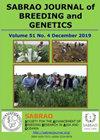生物剂接种玉米种子及其对生长和产量性状的影响
IF 1.7
Q3 PLANT SCIENCES
引用次数: 0
摘要
本研究试图在伊拉克条件下使用植物生长促进微生物(PGPM)作为玉米(Zea mays L.)种子的生物肥料,并确定其在两种水平的矿物肥(25%和50%的化肥)下对玉米生长和生产力的影响。实验室研究证实,无色固氮杆菌与本研究中使用的其他微生物之间没有拮抗作用。田间试验于2021年作物季在伊拉克北部的摩苏尔(36°20′6″N, 43°7′8″E)和基尔库克(35°28′5.02″N, 44°23′31.99″E)两个不同地区进行。结果表明,在玉米生长和产量性状试验中,生物肥料与25%和50%推荐用量的矿物肥配合施用具有优势。在基尔库克市,生物肥料配25%的化学肥料与生物肥料配50%的矿物肥料相比,没有显著差异。然而,在摩苏尔市,生物肥料与50%化肥的组合对玉米的生长和产量性状表现出比其他处理更优越和显著的差异。这两个地区的差异可能是由于化肥残留在土壤中。本文章由计算机程序翻译,如有差异,请以英文原文为准。
MAIZE SEED INOCULATION WITH BIOAGENT AND ITS EFFECTS ON THE GROWTH AND YIELD TRAITS
The presented study sought to use the plant growth-promoting microorganism (PGPM) as a biofertilizer in maize (Zea mays L.) seeds and determine its effects on the growth and productivity of maize, with two levels of mineral fertilizer (25% and 50% of chemical fertilizer) under Iraqi conditions. Laboratory studies confirmed no antagonism between Azotobacter chroococcum and other microorganisms used in this study. Field experiments carried out during crop season 2021 were in two different regions, Mosul (36°20′6″N, 43°7′8″E) and Kirkuk (35°28′5.02″N, 44°23′31.99″E) in the north of Iraq. The result showed biofertilizer superiority when combined with 25% and 50% doses of the recommended mineral fertilizer for maize growth and yield traits in the experiments in both locations. In Kirkuk city, the biofertilizer combined with 25% chemical fertilizer recorded superiority without significant difference from the biofertilizer combined with 50% mineral fertilizer. However, in Mosul city, the biofertilizer combined with 50% chemical fertilizer expressed a more superior and significant difference than other treatments for growth and yield traits in maize. The difference between the two regions might be due to chemical fertilizer residues in the soil.
求助全文
通过发布文献求助,成功后即可免费获取论文全文。
去求助
来源期刊

Sabrao Journal of Breeding and Genetics
农林科学-奶制品与动物科学
CiteScore
1.90
自引率
50.00%
发文量
63
期刊介绍:
The SABRAO Journal of Breeding and Genetics is an international journal of plant breeding and genetics research and was first published in 1969. It is the official publication of the Society for the Advancement of Breeding Research in Asia and Oceania (SABRAO).
Its objectives are to: promote the international exchange of research information on plant breeding and genetics, by describing new research findings, or ideas of a basic or practical nature; and be a medium for the exchange of ideas and news regarding members of the Society.
The Journal gives priority to articles that are of direct relevance to plant breeders and with emphasis on the Asian region. Invited for publication are research articles, short communications, methods, reviews, commentaries, and opinion articles. Scientific contributions are refereed and edited to international standards.
The journal publishes articles for SABRAO members mainly. The Journal preferred strongly that at least one author should be a current member of the Society. Non-members may also publish in the journal.
 求助内容:
求助内容: 应助结果提醒方式:
应助结果提醒方式:


